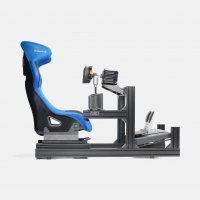Here are some tips to help you find a comfortable and efficient sim racing seating position.
Whether you're clamping a $100 wheel to an ironing board or strapping in to a $20,000 motion cockpit, your seating position matters. A bad seating position can contribute to short and long term health issues, so finding one that works for you is important.
The bad news is that what works for one sim racer might not work for another. The good news is that there are some fundamental tips below to help you get closer to your ideal position.
Something to keep in mind when applying these tips is that comfort and circulation are key. Be sure to find a position that works for you and your body. Using your steering wheel or pedals shouldn't feel effortful, and your seat shouldn't fatigue your body or leave you feeling sore.

As a reminder, these are just general tips for helping you find a comfortable sim racing position, and are not meant to be taken as prescriptive for exactly how you should sit. Adjust your seating and hardware positions to your liking not just to start, but also over time if needed.
Do you have a tip for helping find a comfortable or efficient sim racing seating position? Let us know in the comments below.
Whether you're clamping a $100 wheel to an ironing board or strapping in to a $20,000 motion cockpit, your seating position matters. A bad seating position can contribute to short and long term health issues, so finding one that works for you is important.
The bad news is that what works for one sim racer might not work for another. The good news is that there are some fundamental tips below to help you get closer to your ideal position.
Something to keep in mind when applying these tips is that comfort and circulation are key. Be sure to find a position that works for you and your body. Using your steering wheel or pedals shouldn't feel effortful, and your seat shouldn't fatigue your body or leave you feeling sore.
- Wheel position - Your steering wheel should be positioned in such a way that you can comfortably turn it. To help achieve this, sit at a distance from your wheel where the top of the wheel is at wrist length from your outstretched arm in your normal seating position. If you have the ability to adjust the height of the wheel relative to your body, align it so that the top of the wheel comes about halfway up your face. Many consumer wheels have preset angles for the wheel relative to the wheelbase, but if you're adjusting yours manually, aim the wheel up toward your face slightly (about 10 to 20 degrees). If you've followed these tips, you should be able to grab the sides of your wheel and have your arms form roughly a right angle at the elbow.
- Pedal position - Like your wheel position, your ideal pedal position will mean you can use them with ease. The distance to your pedals from your seating position should allow you to depress them fully while maintaining a slight bend at the knees. The height and angle of your pedal faces aren't always things you'll have the ability to adjust, but if you do, a good starting point is to have the faces slightly below your hips, and angled slightly away from you. Preferences for the height and angle of pedals vary greatly, so make adjustments until you find something comfortable that doesn't compromise the blood circulation in your legs by having the seat pinch the back of your thighs.
- Seating position - Broadly speaking, there are two categories of seat position in sim racing: GT (upright) and formula (reclined). GT seating position tends to be quite straight, perhaps even more vertical than your commuter car, whereas formula seating positions emulating F1 are closer to 45 degrees. The position you decide on can be dictated by the capabilities of your cockpit or the type of race car you're trying to simulate. In sim racing we have the advantage of our seating position not being limited by rollbars or firewalls, so make adjustments to your seat position as needed.
- Shifters and handbrake - Finally, the position of the handbrake and shifter(s) in your setup should be considered. If you have control over the position of your sequential shifter and handbrake, try to find a location close to your steering wheel. Minimizing the time your hand is away from your wheel is one reason for this, and mitigating or eliminating over and under-reaching for your shifter is another. Your H-pattern shifter will often be positioned lower to emulate real world stick-shift cars.
As a reminder, these are just general tips for helping you find a comfortable sim racing position, and are not meant to be taken as prescriptive for exactly how you should sit. Adjust your seating and hardware positions to your liking not just to start, but also over time if needed.
Do you have a tip for helping find a comfortable or efficient sim racing seating position? Let us know in the comments below.

